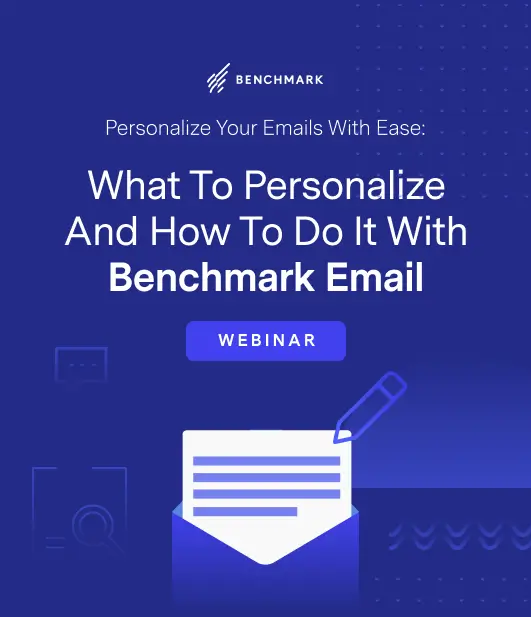
Welcome to the age of the customer, where generic, one-size-fits-all emails just don’t cut it anymore. We’re talking about hyper-personalization—the sophisticated sibling of your run-of-the-mill personalization tactics.
This is the juncture where Artificial Intelligence (AI) rolls up its sleeves and takes your email marketing game to a whole new level.
And when we say “new level,” we mean personalizing every pixel and every word to resonate with individual behaviors, preferences, and real-time needs. No wonder businesses are turning to AI to craft emails that don’t just end up in the spam folder but spark engagement. How can you achieve this? Let’s find out.

Personalize Your Emails with Ease: What to Personalize and How to Do it With Benchmark Email
DOWNLOAD NOWAI-Driven Hyper-Personalization Up Close
Let’s get something straight—hyper-personalization isn’t just splattering first names across email bodies. No, we’re far beyond that. This involves a deep understanding of consumer behavior, something AI does like a pro.
Data-Driven Insights
AI consumes data for breakfast, digesting information from customer interactions, purchase histories, and even social media activities. This rich data diet helps AI models slice and dice your audience into highly targeted segments.
For instance, if you have an eCommerce business, you can feed data to the AI and have it separate them into categories like “weekend shoppers,” “coupon hunters,” or “brand loyalists.” Now, your email content can talk directly to each of these groups, significantly ramping up engagement levels.
Dynamic Content Generation
Now we’re warming up. AI doesn’t just inform your strategy; it can also create content. Using predefined templates and variables, these algorithms whip up product recommendations, exclusive offers, and compelling subject lines, all uniquely tailored to individual recipients. The result? Emails that not only catch the eye but also hold attention.
Behavior Prediction and Automation
AI’s forte lies in its ability to play the long game. What does that mean? It can predict future actions based on historical data. So, if it’s April and you’ve got customers who have a penchant for camping gear, AI queues up relevant email content to coincide with their likely needs come May.
Automating these kinds of predictive engagements ensures timeliness and relevance, minus the human-induced delays or errors.
Benefits for Businesses
OK, it sounds great, but what’s the ROI? With AI-driven hyper-personalization, the gains are palpable.
Reaching KPIs Faster
Another benefit of personalizing your emails with AI is the fact that you can hit your outreach-related KPIs much faster. You can even add A/B testing into the mix and get the necessary data, allowing you to decide upon the right template for every purpose—from pitching leads to closing deals with prospects. Efficiency, meet effectiveness.
Enhanced Customer Engagement
Remember the marketing funnel? AI refines it by delivering the right content at the right time. Whether it’s nudging a first-time visitor with a welcome offer or tempting a lapsed customer with a too-good-to-ignore deal, AI-driven email content has your funnel covered, top to bottom.
The Future Is Already Here
Here’s where the real fun begins. We’re on the cusp of advancements that could redefine what AI can do for email marketing. What we’re seeing now—ChatGPT or Grammarly Go giving you a hand when responding to your colleagues and clients—is just scratching the surface.
As AI models become more powerful, we will be able to generate PDFs with JavaScript and immediately create reports, invoices, and more.
Likewise, it’s possible that some large language models (LLMs) will even be capable of monitoring inboxes and automatically crafting responses, ready to be sent with your approval. Can you imagine how much time that could save?
Proceed with Caution: Risks and Mitigations
While AI might sound like the golden ticket to customer engagement, it’s not without its pitfalls.
Privacy and Data Security
Since you’re dealing with terabytes, if not petabytes of data, securing that data is paramount. Likewise, you should employ robust encryption techniques and comply with regulations like GDPR to ensure that you’re not stepping on any legal landmines.
The Fine Line of Over-Personalization
The allure of hyper-personalization can sometimes tip over into the creepy territory. The solution? Let users control the degree of personalization they’re comfortable with. Give them the reins, and they’re less likely to bolt.
Algorithmic Bias
Data isn’t always neutral, and neither are algorithms trained on them. Periodic auditing can help nip any inadvertent bias in the bud, making sure your email content doesn’t ruffle any feathers. Also, there’s the famous GIGO (garbage in, garbage out) concept, which reinforces the need to verify the data before feeding it to an AI model.
The Evolving Landscape of Personalized Email Content
The world of email marketing is ever-changing, with the integration of AI and machine learning making personalized content not just a perk but a necessity. Below, we dissect what the future of personalized email content has in store for companies and their target demographics.
Hyper-Personalization and AI
Hyper-personalization isn’t some passing fad; it’s an innovative approach that taps into AI to provide a nuanced understanding of individual preferences.
Future technologies will explore beyond basic metrics to construct emails that sync with the user’s emotions, behaviors, and even cultural identifiers. They might even be able to use region-specific slang and similar linguistic intricacies. This is not just about grabbing attention, though—it’s about holding it by making the email communication as human-like as possible.
Emotional Intelligence
Content is moving toward becoming emotionally intelligent. AI will make this possible by evaluating various factors such as response history, writing style, and the type of content interacted with.
This will offer marketers an avenue to establish a deeper emotional connection with their recipients, thereby strengthening brand loyalty.
Predictive Personalization
We are shifting from reactive to predictive personalization. AI algorithms will not only respond to customer behaviors but will also anticipate their future needs and preferences.
Picture this: An email is sent to a customer highlighting a product they might be interested in, even before that product hits the shelves. That’s staying ahead of the curve.
Making Emails Interactive and Immersive
Emails are no longer confined to just text and images. With advancements in augmented reality (AR) and virtual reality (VR), expect email content to offer an interactive and highly engaging user experience.
Whether it’s a virtual try-on for a new pair of sunglasses or exploring a 3D model of a product, the level of engagement is set to skyrocket.
The Rise of Voice-Enabled Personalization
Voice recognition technology is becoming increasingly integrated into our daily lives, thanks to smart speakers and voice assistants.
Future emails will be geared toward auditory experiences, as AI will enable the content to be read aloud based on the user’s preferences. Imagine responding to an email or taking action via voice command—now that’s innovation.
Cross-Channel Consistency
Personalized email content is part of a broader digital marketing ecosystem that includes social media, websites, and other platforms. Therefore, a uniform and complementary experience across these channels is crucial for retaining customer interest and promoting brand cohesion.
Ethical Measures
As personalization techniques become more advanced, there’s a growing need for ethical guidelines, particularly around data privacy. Future strategies will need to be transparent about the use of AI and data collection processes to maintain customer trust. After all, a little honesty goes a long way.
The future of personalized email content is teeming with opportunities to captivate, engage, and retain consumers like never before. With technology rapidly evolving, marketers need to stay updated and adapt accordingly to keep their email strategies not just relevant but revolutionary.
Final Thoughts
AI-driven email marketing isn’t some futuristic pipe dream—it’s here, it’s now, and it’s elevating the customer journey in ways we couldn’t have fathomed a decade ago. From digging into data-driven insights to generating emotionally intelligent and predictive content, the marriage of AI and email marketing is here to not only last but thrive.
So whether you’re a business owner, a marketing aficionado, or just intrigued by where technology is headed, one thing’s for certain: The era of one-size-fits-all emails is behind us. And the road ahead? It’s tailored to each customer, paved with opportunities, and navigated by the ever-advancing capabilities of AI.
Author Bio
Lee Li is a project manager and B2B copywriter from ShenZhen, China, and is currently based out of Singapore. She has a decade of experience in the Chinese fintech startup space as a PM for TaoBao, MeitTuan, and DouYin (now TikTok).







